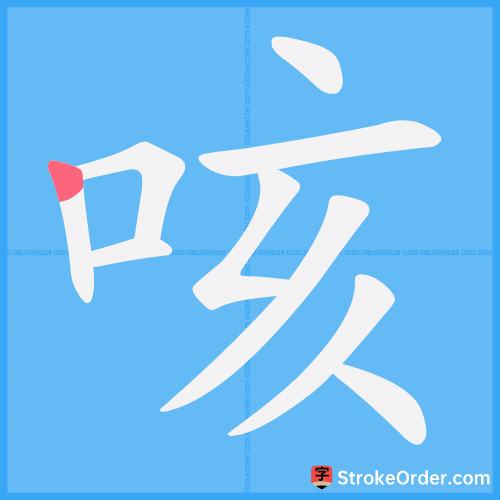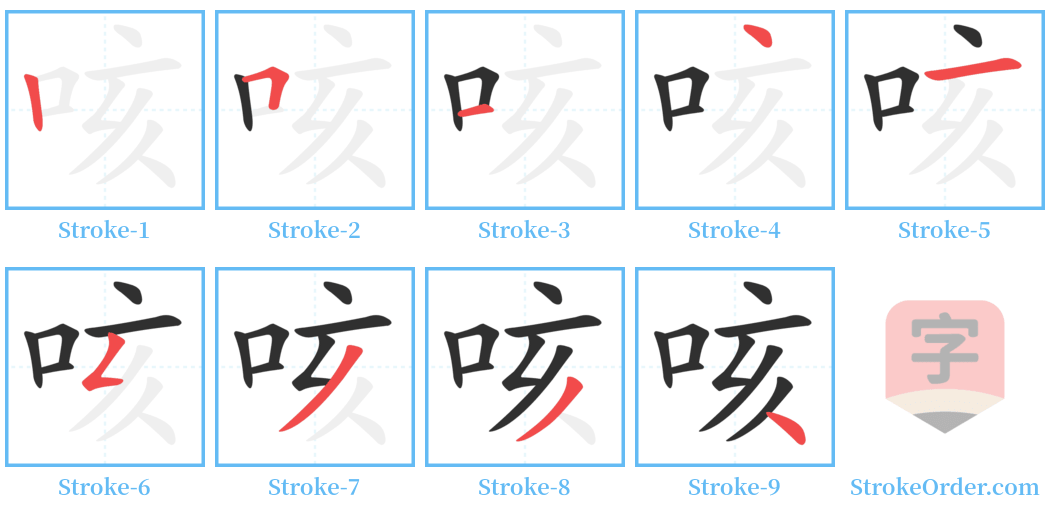咳 Stroke Order
Animated Stroke Order of 咳

Stroke Order Diagrams for 咳

Step-by-Step Handwriting Guide for 咳

Learn to Write Chinese Characters with Video Tutorials
Watch the video of writing the Chinese character "咳", learn the correct stroke order (笔顺) of the character "咳", and master the standard way of writing the character "咳".
Free Printable Handwriting Practice with Stroke Order: 咳
Printable Writing Practice Worksheet of "咳" in Portrait Orientation (Tian Zi Ge)

Printable Writing Practice Worksheet of "咳" in Landscape Orientation (Tian Zi Ge)

Information of 咳
Pinyin
ké、 hāi
Radical
口
Strokes
9 strokes
Usage
★★★★★
Definition
sound of sighing, cough
咳 (ké)
1. Cough: A reflex action triggered by irritation of the respiratory organs. It involves expelling inhaled air quickly while making a sound, which helps to clear away foreign objects or phlegm from the respiratory tract and is also a symptom of certain diseases.
咳 (ké)
本义: 小儿笑。 (“Records of the Grand Historian - Bian Que’s Biography”: "Never reported to cough, the child was just laughing." (Cough child: Infants just starting to laugh.)
造字法:形声。从口,亥(hāi)声,①(hāi)
引:
1. Song - Su Shi “Record of Shizhong Mountain”: "As if the old man coughs and laughs in the valley."
例:
1. 咳唾 (to cough and spit saliva); 咳逆 (a kind of cough disease caused by reversed qi); 咳珠吐玉 (metaphor for beautiful wording); 咳血 (to cough up blood).
2. Sigh.
3. An exclamation word to express regret or remorse.
咳 (hāi)
叹:
1. 啊 ([En.] hi) — Used to express various emotions (such as joy, comfort, regret, or contempt).
2. 哎呀,唉,呜呼 ([En.] alas) — Used to express misfortune, sadness, regret, or concern.
3. 该死! 糟了! ([En.] damn it) — Used as a mild curse.
4. 表示感叹 ([En.] what).
5. 嗨 ([En.] hi) — Used to greet or attract attention.
咳 (hāi)
叹:
1. Sigh ([En.] sigh).
2. 另见 hái; ké.
咳 (hái)
1. 小儿笑 ([En.] child laugh).
2. Later refers to the expression of laughter.
3. 通“阂”。阻隔 ([En.] obstruct).
咳 (hái)
名:
1. 通“孩”。小儿 ([En.] child).
2. 另见 hāi; ké.
咳 (hái)
动:
1. 小儿笑 ([En.] child laugh).
引:
1. "Shuowen": 咳,小儿笑也。从口,亥声。
2. 后泛指笑貌。
例:
1. 如: 咳咳 (laughing appearance), 咳笑 (children laughing).
2. 通“阂”。阻隔 ([En.] obstruct).
引:
1. "Yanzi Chunyǔ": "The neck and tail cough in the universe."
咳 (hái)
名:
1. 通“孩”。小儿 ([En.] child).
引:
1. "Records of the Grand Historian - Bian Que’s Biography”: "Never reported to cough to the infant's appearance."
例:
1. 如: 咳儿; 咳咳 (the appearance of a fetus); 咳婴 (refers to infants who have just started to laugh and still need nursing).
*引自繁体辞典解释*
动:
1. Use force to cough, forcing obstructive objects to expel from the throat. Such as: "cough phlegm," "cough blood," "suddenly cough out a small fish bone."
Input Method for 咳
Pinyin
ke2
Wubi
kynw
Cangjie
ryvo
Zhengma
jszo
Four Corner
60082
Unicode
U+54b3
Same Pronunciation Characters